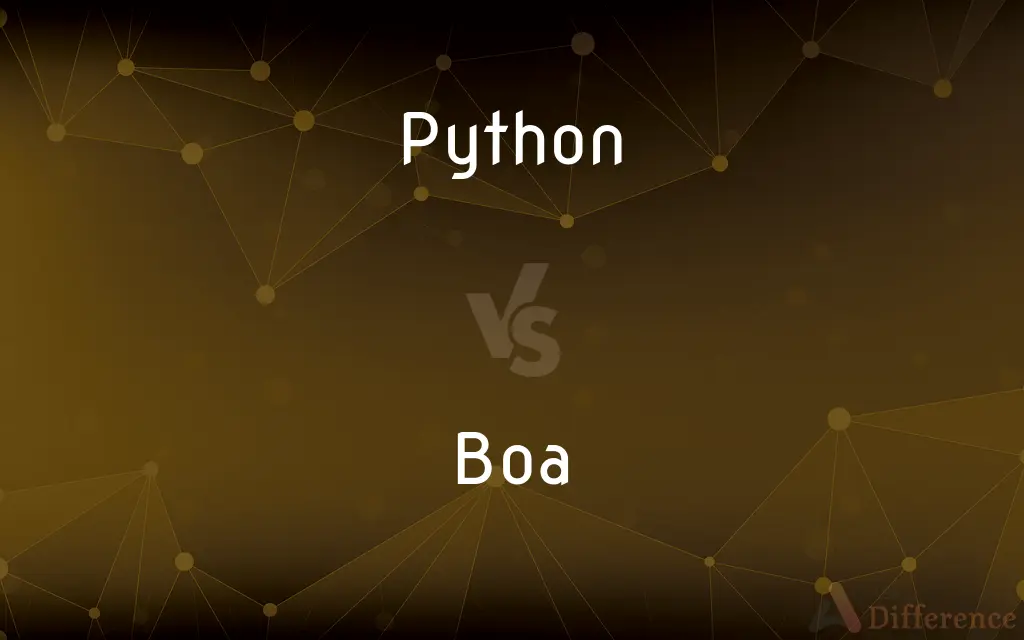Python vs. Boa — What's the Difference?
Edited by Tayyaba Rehman — By Fiza Rafique — Updated on March 16, 2024
Pythons are non-venomous snakes known for their size and constricting method of prey capture, while boas are also non-venomous, but differ in habitat and certain physical features.

Difference Between Python and Boa
Table of Contents
ADVERTISEMENT
Key Differences
Pythons and boas are both large, non-venomous snakes that kill their prey through constriction. While they share similarities in behavior and appearance, they belong to different families: Pythonidae for pythons and Boidae for boas. This distinction is important because it reflects their different evolutionary paths, habitat preferences, and, in some cases, physical characteristics.
Pythons are primarily found in Africa, Asia, and Australia, demonstrating a wider geographic distribution in mainly tropical regions. On the other hand, boas are native to North, Central, and South America, as well as some islands in the Caribbean. This difference in habitat influences their adaptation and survival strategies, with each group developing unique characteristics suitable for their environments.
One of the main physical differences between pythons and boas is the presence of pelvic spurs. Pythons retain these vestigial remnants of hind limbs, which can be seen near their cloaca. Boas also have these spurs, but they are generally less pronounced. These spurs are used during mating to stimulate the female and are a visible sign of their evolutionary past.
Reproduction is another area where pythons and boas differ. Pythons are oviparous, meaning they lay eggs. The female python will often stay with the eggs until they hatch, using her body to generate heat and incubate them. Boas, on the other hand, are mostly ovoviviparous, giving birth to live young. This reproductive strategy reflects adaptations to their specific environmental conditions.
In terms of diversity, both families boast a wide range of species. However, pythons tend to have a slightly greater diversity in size, with some species, like the reticulated python, being among the longest snakes in the world. Boas, while also varying in size, generally do not reach the lengths of the largest pythons. This difference in size can affect their prey choices, habitats, and predation risks.
ADVERTISEMENT
Comparison Chart
Family
Pythonidae
Boidae
Habitat
Africa, Asia, Australia
Americas, Caribbean
Reproduction
Oviparous (lay eggs)
Ovoviviparous (live birth)
Pelvic Spurs
More pronounced
Less pronounced
Size Diversity
Larger range, includes some of the longest snakes
Generally smaller than the largest pythons
Compare with Definitions
Python
Non-venomous constrictor.
The Burmese python wraps around its prey, suffocating it before consumption.
Boa
Americas habitat.
Boas are native to the Americas and the Caribbean, adapting to a variety of environments.
Python
Presence of pelvic spurs.
Pythons have visible vestigial remnants of hind limbs near their cloaca.
Boa
Ovoviviparous reproduction.
A boa gives birth to live young, fully developed inside the mother.
Python
Oviparous reproduction.
A female python lays eggs and may incubate them until they hatch.
Boa
Non-venomous constrictor.
Boas kill their prey by coiling around it and tightening their grip.
Python
Tropical distribution.
Pythons are primarily found in the tropical regions of Africa, Asia, and Australia.
Boa
Subdued pelvic spurs.
Boas also have pelvic spurs, though they are generally less pronounced than in pythons.
Python
Diverse size range.
The reticulated python is known as one of the longest snakes in the world.
Boa
Variety in size.
While boas vary in size, they generally do not reach the length of the largest pythons.
Python
A large heavy-bodied non-venomous snake occurring throughout the Old World tropics, killing prey by constriction and asphyxiation.
Boa
A constrictor snake which bears live young and may reach great size, native to America, Africa, Asia, and some Pacific islands.
Python
A high-level general-purpose programming language.
Boa
A long, thin decorative scarf made of feathers or a similar material, worn by women at parties or as part of fancy dress
A sequinned ballgown and feather boa
Python
Greek Mythology A dragon or serpent that was the tutelary demon of the oracular cult at Delphi until killed and expropriated by Apollo.
Boa
Any of various large, nonvenomous, chiefly tropical snakes of the family Boidae, which includes the anacondas, the boa constrictor, and other snakes that coil around and asphyxiate their prey.
Python
A soothsaying spirit or demon.
Boa
A long fluffy scarf made of soft material, such as fur or feathers.
Python
A person possessed by such a spirit.
Boa
Any of a group of large American snakes, of the genus Boa, subfamily Boinae, or family Boidae, including the boa constrictor and the emperor boa of Mexico.
Python
Any of various nonvenomous snakes of the family Pythonidae, found chiefly in Asia, Africa, and Australia, that coil around and asphyxiate their prey. Some pythons can attain lengths of 8 meters (26 feet) or more.
Boa
(plural "boas") A type of long scarf; typically made from synthetic or real feathers (or occasionally fur), and usually worn by being draped across the shoulders with the ends hanging low, sometimes also with a loop around the neck.
Python
A type of large constricting snake.
Boa
A genus of large American serpents, including the boa constrictor, the emperor boa of Mexico (Boa imperator), and the chevalier boa of Peru (Boa eques).
Python
A penis.
Boa
A long, round fur tippet; - so called from its resemblance in shape to the boa constrictor.
Python
Any species of very large snakes of the genus Python, and allied genera, of the family Pythonidæ. They are nearly allied to the boas. Called also rock snake.
Boa
A long thin fluffy scarf of feathers or fur
Python
A diviner by spirits.
Boa
Any of several chiefly tropical constrictors with vestigial hind limbs
Python
Large Old World boas
Python
A soothsaying spirit or a person who is possessed by such a spirit
Python
(Greek mythology) dragon killed by Apollo at Delphi
Common Curiosities
Are pythons or boas venomous?
Neither pythons nor boas are venomous; both kill their prey through constriction.
Where can you find pythons in the wild?
Pythons are primarily found in Africa, Asia, and Australia, in tropical regions.
What are pelvic spurs in these snakes?
Pelvic spurs are vestigial remnants of hind limbs found near the cloaca, more pronounced in pythons.
Can pythons be found in the Americas?
While not native, some python species have established invasive populations in parts of the Americas.
What is the difference in the reproductive methods of pythons and boas?
Pythons lay eggs (oviparous), while boas give birth to live young (ovoviviparous).
How do boas reproduce?
Most boas are ovoviviparous, giving birth to live young.
What is the largest species of python?
The reticulated python is considered one of the longest snake species in the world.
Do boas live in Africa or Asia?
Boas are native to the Americas and some islands in the Caribbean, not Africa or Asia.
Why do these snakes have pelvic spurs?
Pelvic spurs are thought to be used during mating and are a sign of their evolutionary past.
Are all boas large snakes?
While boas can grow large, their size varies significantly across different species.
What habitats do boas prefer?
Boas inhabit a variety of environments in the Americas, from forests to deserts.
What adaptations help pythons and boas constrict their prey?
Both have strong, muscular bodies enabling them to coil tightly around prey and suffocate it.
How do pythons incubate their eggs?
Female pythons may wrap around their eggs and shiver to generate heat, aiding incubation.
Is the python population increasing globally?
The population status varies by species; some are threatened, while others may be increasing due to human introduction.
Can boas and pythons interbreed?
Boas and pythons are from different families and cannot interbreed.
Share Your Discovery

Previous Comparison
Plan vs. Strategy
Next Comparison
Fsh vs. LhAuthor Spotlight
Written by
Fiza RafiqueFiza Rafique is a skilled content writer at AskDifference.com, where she meticulously refines and enhances written pieces. Drawing from her vast editorial expertise, Fiza ensures clarity, accuracy, and precision in every article. Passionate about language, she continually seeks to elevate the quality of content for readers worldwide.
Edited by
Tayyaba RehmanTayyaba Rehman is a distinguished writer, currently serving as a primary contributor to askdifference.com. As a researcher in semantics and etymology, Tayyaba's passion for the complexity of languages and their distinctions has found a perfect home on the platform. Tayyaba delves into the intricacies of language, distinguishing between commonly confused words and phrases, thereby providing clarity for readers worldwide.
















































